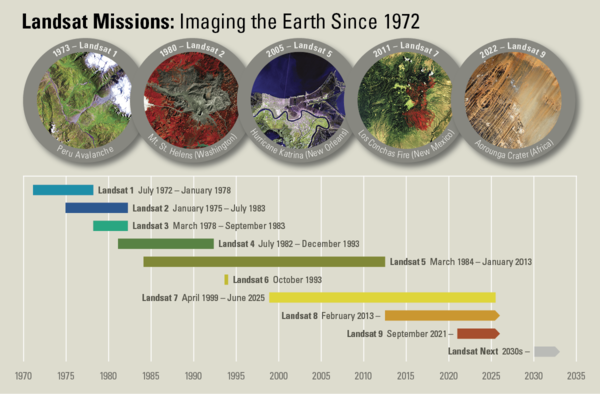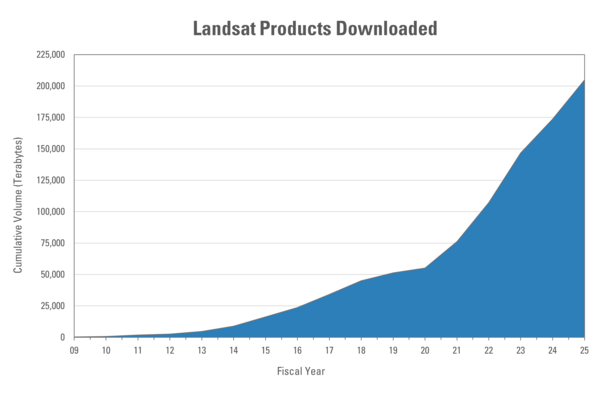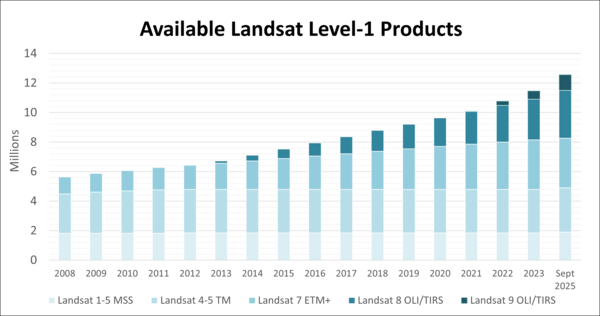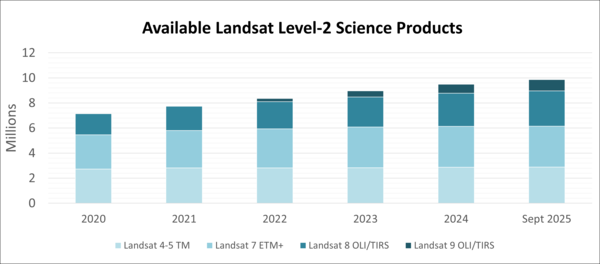In a September 21, 1966 press release, Secretary of the Interior Stewart Udall announced that the DOI was launching "Project EROS (Earth Resources Observation Satellites)." Udall's vision was to observe the Earth for the benefit of all.
Multimedia
Explore the USGS Multimedia for access to images, videos, podcasts, and webcams. All items are considered public domain unless otherwise noted.
Images
In a September 21, 1966 press release, Secretary of the Interior Stewart Udall announced that the DOI was launching "Project EROS (Earth Resources Observation Satellites)." Udall's vision was to observe the Earth for the benefit of all.
This graphic displays the cumulative volume of all operational Landsat products downloaded from the USGS EROS Landsat archive since December 2008 (FY2009). The release of Landsat Collection 2 products in 2020, which improved data quality and accessibility, helped drive downloads upward.
This graphic displays the cumulative volume of all operational Landsat products downloaded from the USGS EROS Landsat archive since December 2008 (FY2009). The release of Landsat Collection 2 products in 2020, which improved data quality and accessibility, helped drive downloads upward.
This graph shows the number of Landsat Collection 2 Level-1 scene-based products that are available for download from the USGS Archive. Please note that data from earlier Landsat missions, even those that have ended, continues to be added to the archive through the Landsat Global Archive Consolidation (LGAC) program.
This graph shows the number of Landsat Collection 2 Level-1 scene-based products that are available for download from the USGS Archive. Please note that data from earlier Landsat missions, even those that have ended, continues to be added to the archive through the Landsat Global Archive Consolidation (LGAC) program.
This graphic displays the number of Landsat Collection 2 Level-2 scene-based science products that are available for download from the USGS Archive. Level-2 science products were first introduced with the Collection 2 release in December, 2020. The Level-2 Science Product includes surface reflection and surface temperature data.
This graphic displays the number of Landsat Collection 2 Level-2 scene-based science products that are available for download from the USGS Archive. Level-2 science products were first introduced with the Collection 2 release in December, 2020. The Level-2 Science Product includes surface reflection and surface temperature data.
Landsat data improve people's quality of life! The impacts and benefits of the Landsat Program and satellite data archive are felt worldwide. A 2023 report highlights Landsat's estimated value at \$25.6 billion in economic return.
Landsat data improve people's quality of life! The impacts and benefits of the Landsat Program and satellite data archive are felt worldwide. A 2023 report highlights Landsat's estimated value at \$25.6 billion in economic return.
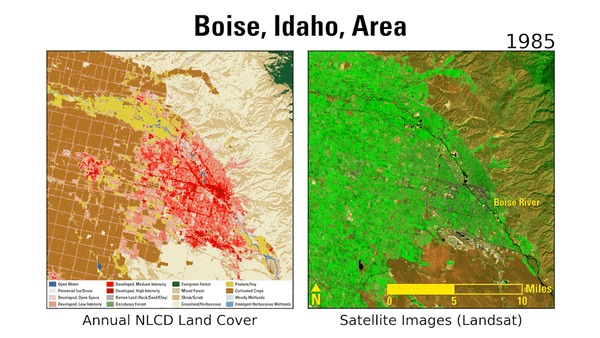
Annual NLCD and Landsat animations of the Boise, Idaho, area
Annual NLCD and Landsat animations of the Boise, Idaho, areaThis animation shows Treasure Valley, part of the Snake River Valley and home to the Boise, Idaho, metro area. The Boise Mountains lie to the east, and cropland and pasture/hay land lie to the west. The area’s population has seen significant growth in recent decades, far more than doubling between 1990 and now to above 800,000.
Annual NLCD and Landsat animations of the Boise, Idaho, area
Annual NLCD and Landsat animations of the Boise, Idaho, areaThis animation shows Treasure Valley, part of the Snake River Valley and home to the Boise, Idaho, metro area. The Boise Mountains lie to the east, and cropland and pasture/hay land lie to the west. The area’s population has seen significant growth in recent decades, far more than doubling between 1990 and now to above 800,000.
Videos
 Title slide with illustration of satellite above the Earth and text alongside
Title slide with illustration of satellite above the Earth and text alongside
Landsat: Products & Services from the USGS - Webinar, September 2023
Landsat: Products & Services from the USGS - Webinar, September 2023The USGS Earth Resources Observation and Science (EROS) Center maintains the largest civilian collection of images of the Earth’s land surface. At EROS we study land change and produce land change data products used by researchers, resource managers, and policymakers across the nation and around the world.
Landsat: Products & Services from the USGS - Webinar, September 2023
Landsat: Products & Services from the USGS - Webinar, September 2023The USGS Earth Resources Observation and Science (EROS) Center maintains the largest civilian collection of images of the Earth’s land surface. At EROS we study land change and produce land change data products used by researchers, resource managers, and policymakers across the nation and around the world.
 Landsat 1 First Light Image over Dallas, Texas
Landsat 1 First Light Image over Dallas, Texas
Landsat Records 50 Years of Growth in Dallas-Fort Worth
Landsat Records 50 Years of Growth in Dallas-Fort WorthLandsat 1 celebrated its 50th anniversary on July 23, 2022!
Landsat 1's first satellite image shared with the world was a view of Dallas-Fort Worth, Texas. Over the course of five decades, Landsat satellites have captured the Dallas-Fort Worth area 2033 times, compiled into individual scenes in the Landsat Archive.
Landsat Records 50 Years of Growth in Dallas-Fort Worth
Landsat Records 50 Years of Growth in Dallas-Fort WorthLandsat 1 celebrated its 50th anniversary on July 23, 2022!
Landsat 1's first satellite image shared with the world was a view of Dallas-Fort Worth, Texas. Over the course of five decades, Landsat satellites have captured the Dallas-Fort Worth area 2033 times, compiled into individual scenes in the Landsat Archive.
The Landsat program conceived of in the 1960s, has been running longer than any remote sensing program. The idea was simple: position a satellite in a nearly polar orbit fixed to the solar angle so that each daytime pass would cross the equator at roughly the same local time.
The Landsat program conceived of in the 1960s, has been running longer than any remote sensing program. The idea was simple: position a satellite in a nearly polar orbit fixed to the solar angle so that each daytime pass would cross the equator at roughly the same local time.
 color thumbnail for USGS EROS Image of the Week - Landsat's 10 Millionth Scene
color thumbnail for USGS EROS Image of the Week - Landsat's 10 Millionth Scene
Landsat 7 had the honor of acquiring the satellite program’s 10 millionth scene in November 2021.
The scene captures changes to the Dead Sea, located in Southwest Asia. The Dead Sea is mainly fed by the Jordan River, which enters from the north. However, the water level of the Dead Sea has been falling due to irrigation projects and water use upstream.
Landsat 7 had the honor of acquiring the satellite program’s 10 millionth scene in November 2021.
The scene captures changes to the Dead Sea, located in Southwest Asia. The Dead Sea is mainly fed by the Jordan River, which enters from the north. However, the water level of the Dead Sea has been falling due to irrigation projects and water use upstream.
Since 1972, Landsat satellites have continually acquired data about the Earth’s land surface. On November 23, 2021, the Landsat Archive that stores this vital record added its ten millionth scene.
The history of the area on display in that milestone scene offers insight into the value of the Landsat Program’s longevity to the scientific community.
Since 1972, Landsat satellites have continually acquired data about the Earth’s land surface. On November 23, 2021, the Landsat Archive that stores this vital record added its ten millionth scene.
The history of the area on display in that milestone scene offers insight into the value of the Landsat Program’s longevity to the scientific community.
The newly launched Landsat 9 experienced a once-in-a-mission lifetime event where its orbit was directly below Landsat 8 for an “underfly.” For several days in the middle of November, the pair of Earth-observing satellites flew together, collecting data at the same time for the same sites and requiring simultaneous downlinking to global ground station antennas.
The newly launched Landsat 9 experienced a once-in-a-mission lifetime event where its orbit was directly below Landsat 8 for an “underfly.” For several days in the middle of November, the pair of Earth-observing satellites flew together, collecting data at the same time for the same sites and requiring simultaneous downlinking to global ground station antennas.
Audio


Eyes on Earth Episode 131 – Using AI in Geospatial Work
Eyes on Earth Episode 131 – Using AI in Geospatial WorkEyes on Earth tackles artificial intelligence (AI) in a 2-part episode. AI is quickly becoming a necessary part of geospatial work at EROS, helping us efficiently do science to better manage our world. In Part 1, EROS Director Pete Doucette discusses AI and its current and upcoming impact on our work at EROS.
Eyes on Earth Episode 131 – Using AI in Geospatial Work
Eyes on Earth Episode 131 – Using AI in Geospatial WorkEyes on Earth tackles artificial intelligence (AI) in a 2-part episode. AI is quickly becoming a necessary part of geospatial work at EROS, helping us efficiently do science to better manage our world. In Part 1, EROS Director Pete Doucette discusses AI and its current and upcoming impact on our work at EROS.


Every pixel has a story. At least that’s how land remote sensing scientist Jo Horton sees it. The new Annual National Land Cover Database (NLCD) was just released in October 2024. NLCD is widely used for land cover and change research in the U.S.
Every pixel has a story. At least that’s how land remote sensing scientist Jo Horton sees it. The new Annual National Land Cover Database (NLCD) was just released in October 2024. NLCD is widely used for land cover and change research in the U.S.


Eyes on Earth Episode 129 – What Happens During a Landsat Pass?
Eyes on Earth Episode 129 – What Happens During a Landsat Pass?In this episode of Eyes on Earth, we talk to ground station technicians to find out how Landsat satellite data gets from the spacecraft to EROS and then to the archive. We see what it’s like in EROS’s Landsat operations room and what the technicians do before, during, and after a Landsat pass.
Eyes on Earth Episode 129 – What Happens During a Landsat Pass?
Eyes on Earth Episode 129 – What Happens During a Landsat Pass?In this episode of Eyes on Earth, we talk to ground station technicians to find out how Landsat satellite data gets from the spacecraft to EROS and then to the archive. We see what it’s like in EROS’s Landsat operations room and what the technicians do before, during, and after a Landsat pass.


Eyes on Earth Episode 127 – The Historic Landsat 7 Mission
Eyes on Earth Episode 127 – The Historic Landsat 7 MissionIn this episode of Eyes on Earth, we talk about the incredible career of Landsat 7, which collected science imagery of the Earth for nearly 25 years. The Flight Operations Team at NASA Goddard Space Flight Center and engineers at EROS work together to collect imagery, send commands to the satellite, and keep it healthy.
Eyes on Earth Episode 127 – The Historic Landsat 7 Mission
Eyes on Earth Episode 127 – The Historic Landsat 7 MissionIn this episode of Eyes on Earth, we talk about the incredible career of Landsat 7, which collected science imagery of the Earth for nearly 25 years. The Flight Operations Team at NASA Goddard Space Flight Center and engineers at EROS work together to collect imagery, send commands to the satellite, and keep it healthy.


In this episode of Eyes on Earth, we talk to forest ecologist Jim Lutz about the effort to map fires in Utah. Fire research in the West is dominated by the study of large fires, but the forests in Utah are different. Utah typically does not have a lot of large fires as other western states do.
In this episode of Eyes on Earth, we talk to forest ecologist Jim Lutz about the effort to map fires in Utah. Fire research in the West is dominated by the study of large fires, but the forests in Utah are different. Utah typically does not have a lot of large fires as other western states do.


This Eyes on Earth episode is the third in our series on using Landsat for coastal studies. We talk to physical geographer Jeff Danielson about bathymetry and how it is critical for coastal modeling. Bathymetry captures the shape of underwater topography, and satellite-derived bathymetry helps fill in areas where there are data gaps.
This Eyes on Earth episode is the third in our series on using Landsat for coastal studies. We talk to physical geographer Jeff Danielson about bathymetry and how it is critical for coastal modeling. Bathymetry captures the shape of underwater topography, and satellite-derived bathymetry helps fill in areas where there are data gaps.




